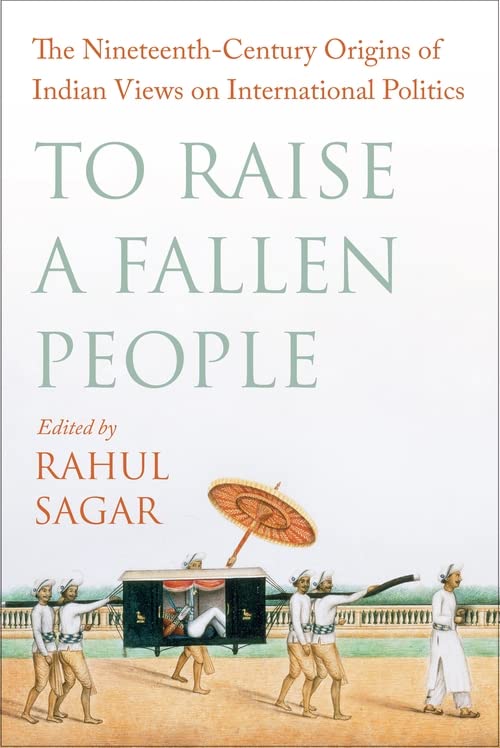Book Review: To Raise A Fallen People: How Nineteenth-Century Indians Saw Their World and Shaped Ours

Rahul Sagar’s To Raise A Fallen People: How Nineteenth-Century Indians Saw Their World and Shaped Ours provides a window into the Indian approach towards international affairs by going back to the conceptually formative years of the nation-state.
There exists the belief, not unchallenged though, among a section of foreign policy analysts that India’s foreign policy lacks a grand strategic framework and is driven by ad-hoc considerations. This scholarly debate on the deeper sources of India’s international conduct become important in the context of India’s economic and military rise.
In discussing the 19th-century Indian thinkers’ approach to foreign policy issues, Sagar first debunks the notion that Indians have not systematically thought about international affairs. A thematically curated anthology of 19th-century Indian writings, To Raise a Fallen People shows convincingly that under the colonial yoke, “eminent” Indians debated with passion the issues of the Great Game, racism, military expenditure, free trade, and relations with the West among others.
Undergirding most of the writings in the anthology is the sense of India’s status as a deprived and subjugated nation as well as a strong will to raise its rank among the comity of nations. The essays in the anthology capture Indian thinkers’ pragmatism in emulating and reforming their own society, a growing disillusionment with and critique of the British rule, and even the desire to teach the West what the good life entails.
Several cultural observations stand out in these essays written in the context of an India trying to gain national consciousness while being governed by a colonial empire and witnessing the combined and uneven spread of modernity. In referencing to the Indian civilization and its past glories, these 19th-century thinkers almost always equivocated it with the Hindu civilization. Such an approach reflected the then prevalent historical periodization on the basis of religion, but it ran the risk of ignoring the formative role of the medieval period. In doing so, it did not give due weight to those components of the subcontinent’s ancient “little” culture that did not conform to the “great” Hindu scriptural tradition.
Moreover, these writers often uncritically accepted in their own writings the civilized-barbarian dichotomy generated in the West with racist overtones. The analyses of the West’s rise, India’s decline, and pathway for development also resorted to cultural factors as the causal driver. For instance, the West’s rise was seen to be based on the Christian values of rationality, sense of duty, societal coherence, and industriousness. Indians, in stark contrast, were indolent and lacked in sense of national unity. From the perspective of social science, the analysis involving cultural factors as independent variables impacting national development becomes difficult to operationalise. It also runs the risk of cherry-picking, reinforcing stereotypes, and essentialising at the expense of actual diversity.
One rather persistent trope rooted in the 19th-century writings that sustains to this day is the dichotomy between the materialist West and spiritually superior East. Sagar argues that while this trope was first developed by Orientalist scholars to justify their field of study in eyes of Western audiences, Indian nationalists soon lapped it up. Stung by the political subjugation, economic backwardness, and racist characterisation as an effeminate group, Indian nationalists took a culturalist turn to salvage their wounded pride and to fashion a shared national consciousness.
As Sagar argues, it was not just Hindu nationalists but prominent nationalists like Annie Besant, Mahatma Gandhi, and Jawaharlal Nehru who took resort in the supposed spiritual greatness of the Indian civilisation. However, it is telling that for all the pretence of spiritual superiority, Sagar’s book features quite a few emulative essays which sought to replicate the Western and Japanese achievements in industrialised development. Nehru himself, as the first Prime Minister of independent India, was a moderniser par excellence. In any case, the longue duree persistence of fashioning of the national “Self” in civilisationally exceptional terms can be seen in postcolonial India’s diplomatic conduct on international platforms.
Another persistent idea with its roots in the anti-colonial movement that has come to shape postcolonial Indian policy is that of swadeshi, rebooted as the atmanirbhar Bharat policy by the current government. As a form of economic nationalism, Swadeshi sought to turn the Indian economy self-reliant by boycotting western goods. Importantly, Sagar convincingly argues that swadeshi in its 19th-century avatar was not an autarkic conception, as Gandhians and socialists would demand later. Rather, angered at the colonial administration’s discriminatory economic policy, swadeshi was devised as a form of infant industry protection policy, with consumer preference serving as the driving instrument of shoring up Indian manufacturing.
This economic nationalist preference for trade protectionism has definitely been the dominant stream of Indian economic thinking. Even the stalwart first-generation Indian liberals leaned more towards communitarianism and the free trade variant of classical liberalism did not find much purchase among them. In this context, it is rather surprising to come across Kissen Mohan Malik’s defence of free trade, which blamed India’s deindustrialization on British mills’ technological proficiency and economies of scale. Malik also saw cheap products from Manchester mills as beneficial for millions of poor Indians. Further, the potential lessons from Japan’s stupendous rise as an economic powerhouse in the late 19th century did not go unnoticed. P. Ananda Charlu wanted Indian capitalists to emulate Japan in investing in cutting-edge technology which will allow it to leverage free trade.
These exceptions notwithstanding, owing partly to the devastating impact of the Great Depression and the successful industrialisation of the Soviet Union, Indian economic planners went the import-substitution and Five Year Plans way to develop the nation and preserve economic sovereignty. Indian neoliberals like B. R. Shenoy and Minoo Masani turned out to be the dissenting voices in the wilderness.
Sagar’s book makes an authoritative intervention in the contemporary debate on India’s approach to international relations. The debates on economic policy, civilisational roots, importance of English education, diplomatic identity, and defensive military posture have resonance even today. In this sense, Sagar’s work deserves appreciation for unearthing the continuity in India’s foreign policy conduct and international identity.
Sections on what India can teach the West and defensive military posturing are of particular importance with its explanatory potential for a rising India’s strategic and diplomatic conduct. To Raise a Fallen People, thus, is a must-read not only for historians interested in India’s internationalist thinking but also for policymakers and IR scholars who seek to understand the deep roots of how India thinks and behaves as a rising power.
The sequel to this book dealing with the 20th-century Indian internationalist thinking will be worth watching out for at least two reasons. First, what was the context in which Indian leaders came to adopt the path of import-substitution industrialization instead of emulating Japan’s export-oriented and technology-based development path? Specifically, it would be interesting to see if factors other than the Great Depression and Soviet planning influenced Indian thinking on the matter.
Second, what do archives tell us about the pre-independence roots of India’s non-aligned approach toward superpower rivalry? In explaining the pre-independence attitudes that predicted the post-independence policy of non-alignment, T. A. Keenleyside briefly alludes to the Indian opposition to power blocs and military alliances as sources of fear and tension which can lead to war. Based on extensive archival mining, Sagar’s upcoming sequel can test this hypothesis.
This is a review of: Rahul Sagar, To Raise A Fallen People: How Nineteenth-Century Indians Saw Their World and Shaped Ours, (Columbia University Press: 2022). Paperback: 9780231206457
Sanjeet Kashyap (@sanjeet38) is a Ph.D. candidate at the Centre for International Politics, Organization and Disarmament, School of International Studies, Jawaharlal Nehru University, New Delhi. He also holds a MA degree in Politics and International Studies from SIS, JNU.
This article is published under a Creative Commons Licence and may be republished with attribution.





